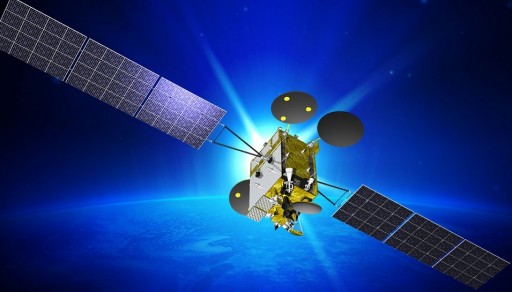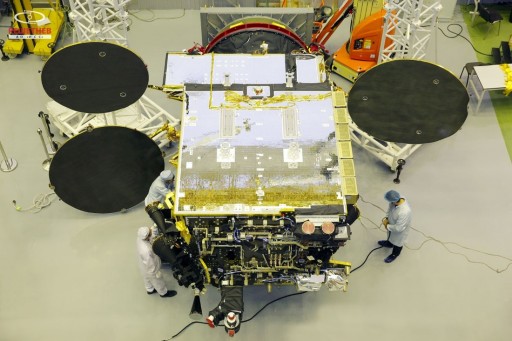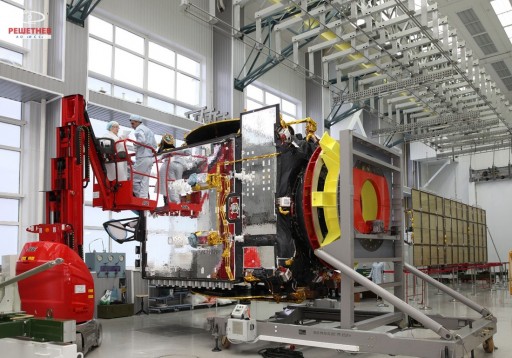Ekspress AM-8

Ekspress AM-8 is a Geostationary Communications Satellite operated by the Russian Satellite Communications Company and manufactured in a partnership between ISS Reshetnev building the satellite platform and Thales Alenia Space providing the multi-band communications payload. The satellite will cover Europe, Africa, the Middle East and South America, delivering a variety of communications services.
Part of the Ekspress communications satellite program, the spacecraft will join a project that started back in 1994 to bridge the technology gap between Russian and Western Telecommunications Satellites. Now, Ekspress satellites are delivering global communications services using spacecraft built in Russia, provided by international satellite builders and cooperative efforts between companies creating a robust communications architecture for TV, Internet, radio and data services for commercial and government customers.
The Ekspress satellite fleet includes the most powerful commercial communications satellites under Russian operation with several satellites launched per year to expand services on a global scale.

Ekspress AM-8 is based on the Ekspress-1000NTB satellite bus manufactured by Reshetnev as a smaller alternative to the Ekspress-2000 spacecraft that hosts powerful communications payloads. Ekspress-1000NTB is capable of hosting mid-sized communication payloads providing propulsion, power generation, power storage and distribution, precise navigation and accurate Earth pointing and stationkeeping capabilities. Two deployable solar arrays deliver a total payload power of 5,880 Watts (EOL).
Ekspress AM-8 has a launch mass of 2,100 Kilograms carrying a payload of 661 Kilograms. The Thales-built communications payload consists of 24 C-Band, 12 Ka-Band and two L-Band transponders.
Two fixed C-Band coverage zones are provided by the satellite, one covering Europe, the northern half of the African continent, and the Middle East, and the other providing coverage to South America and the east coast of North America. The Ka-Band payload serves three coverage zones – a European Beam provides services to Europe and the Middle East, an African Bean delivers coverage to the entire African continent, Madagascar and the Arabian Peninsula; the third Ka-Band zone covers South America in its entirety as well as the eastern regions of the U.S.

Ekspress AM-8 will be stationed at an orbital position of 14 degrees west from where it will operate for at least 15 years.
Between 1994 and 2001, two first generation Ekspress satellites and four improved Ekspress A satellites were launched (one was destroyed in a launch failure). The Ekspress AM series of satellites was inaugurated in 2003 and represents powerful communication satellites with long on-orbit service lives and flexible communication payloads. Fourteen Ekspress AM satellites were launched to date – Ekspress AM-4 did not reach its correct orbit in 2011 and was disposed via a targeted re-entry and its replacement satellite was lost in a Proton-M launch failure in May 2014. In addition to Ekspress AM satellites, Ekspress MD satellites are being launched to maintain an alternate supplier of communications satellites as the MD spacecraft are built by Khrunichev.
Two Ekspress MD satellites were launched in 2009 and 2012, but the last launch left the satellite in a useless orbit after an upper stage failure – three more MD satellites are on contract for launch in the next decade. Ekspress AM-5 was launched in late 2013 and represented the most powerful commercial communications satellite launched in the Ekspress series.
In 2014, a duo of Ekspress AT satellites was delivered to orbit to provide communication services across the entire Russian territory. The Ekspress AM-6 satellite, also built by Reshetnev, was launched in 2014 providing C- and Ku-Band coverage to Russia, Europe and Africa. The AM-7 satellite joined the fleet very recently, launching in March 2015 to deliver Internet, Radio & TV to Europe, Asia and Africa.
Over the coming years, new Ekspress versions will be inaugurated including the AMU and RV series while launches of the AM series will continue.
